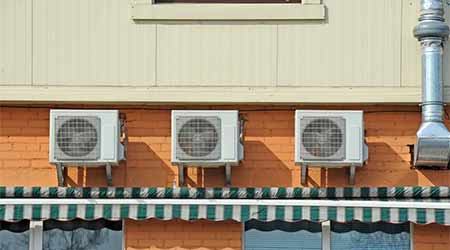Application Insights for VRF Systems
Part three of a three-part article on VRF technology
Each indoor unit includes cooling coils that require a condensate drain. The location of these drains will lead to a complex gravity drain piping system and floor drains in multiple locations. Some indoor units come with a standard condensate lift mechanism to assist with gravity drain from ceiling-mounted units. A strategic layout of the indoor equipment is advised, given that each unit has a fan, compressor and filter that need clearances and periodic maintenance. All components are small and readily accessible within the indoor unit.
VRF systems have room computerized controls, as well as system controls. The room controls provide multiple user adaptive controls, and many include wireless technology and large digital displays. Most VRF manufacturer controls are unique and communicate to non-VRF equipment through BACnet or LonWorks interfaces, which can limit interface communication. Managers need to be careful in planning the way a VRF system communicates with building exhaust fans, ventilation units and campus monitoring systems.
Heating and cooling demands at the room level are determined in the same manner as many other systems. Envelope, internal and outside air loads are part of any cooling or heating demands for a room. The VRF room units must have capacity to meet these requirements at the peak time for both cooling and heating.
In many VRF applications, outside air requirements are induced into the space with a separate ventilation unit. Many include a heat-recovery component that transfers heat from the room exhaust to the room outside. If separate ventilation is not used, each VRF indoor unit has a small, outdoor-air duct connection. Codes vary by region, and in some cases VRF systems must include an integrated air-side economizer to meet local regulations.
The zone loads of any system typically do not amount to the summation of the peaks of each room calculation. VRF adds even more complexity and benefits. A typical air system zone peak load is determined through an hourly analysis and depends on envelope exposure, occupancy schedules and internal load schedules. If the zone contains rooms with varying exposure and varying schedules, the actual peak cooling and heating load is set at the hour and day of the peak. A VRF system adds one more benefit. It not only is sized at the zone load, but the system shares heating and cooling when available.
VRF system loads are determined by the summation of the zone loads and are sized to accommodate peak cooling and heating demands. Sharing energy between rooms only serves as a benefit with varying loads. In the cooler months, when the entire system is in heating mode, the outdoor equipment must be sized to accommodate the entire load.
Mark Stavig, P.E., is a principal with Mazzetti, a global provider of MEP design and consulting. Stavig has more than 30 years of experience in project management and mechanical design for multiple projects of varying scopes and sizes, including government, military, corrections, cultural, higher education, K-12 education, high-rise mixed-use and residential, and healthcare facilities.
Related Topics:














